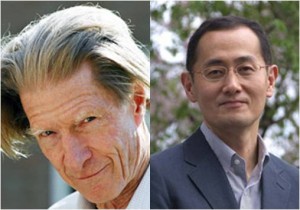WEDNESDAY, 10 OCTOBER 2012
Awarded each year by Stockholm’s Karolinska Institutet, the Nobel Prize for Physiology or Medicine recognises significant scientific advancements in biology, often spanning decades of research. This year, the award recognises the research into stem and developmental biology that is paving the way for a new era of regenerative medicine.During the development of an organism, the information-carrying DNA that resides within the nucleus accumulates modifications, gradually restricting the genes expressed to those for a specific ‘lineage’ or cell type. For example, a nerve cell expresses only the genes required for its structure and function, and not those required for blood, muscle or bone cells. Fundamentally, it was long believed that once a cell had matured, it could not revert to a previous or different state.
John Gurdon is a pioneer of somatic cell nuclear transfer, which takes the nucleus – which contains the DNA - from an adult, or somatic cell, and transfers it into an egg cell that has had its own nucleus removed. The environment of the egg can alter the DNA modifications, reprogramming the genetic material back to an embryonic state before the genes were shut off, and allowing an entire organism to develop from what was once an adult cell. As a PhD student in 1958, Gurdon cloned frogs by using the nucleus from a tadpole intestinal cell to create an organism genetically identical to the donor, and which later paved the way to cloning mammals in the form of Dolly the sheep. Much of his subsequent career has focused on understanding the mechanisms that reprogram the somatic cell nucleus.
However, eggs are in short supply and in the meantime embryonic stem cells have been discovered, and much has been determined about how they function. This enabled Shinya Yamanaka and his team to take the idea one step further in 2006, by directly reprogramming somatic cells without the need for the environment of the egg. To do this, the group infected the cells with proteins called transcription factors, which regulate which genes a cell expresses. They used a suite of factors known to be important in the early embryo at the stage when embryonic stem cells can be isolated. They eventually determined that just four of the factors were sufficient to reprogram adult cells, from both mouse and human, back to a stem cell-like state. In mice, these cells were then able to generate fertile adults, the ultimate test of the success of reprogramming.
The combined achievement of Gurdon and Yamanaka is in demonstrating the incredible plasticity of life, and how it might be harnessed for medicine. While stem cell biology is still somewhat in its infancy and the promise of regenerative medicine still floats just out of reach, they have pushed us in the right direction by showing that it is possible to create stem cells without the need for the destruction of an embryo. Much work has since gone into developing protocols to turn these embryonic cells into many of the mature cell types of the adult body. The expected outcome is twofold: firstly, cells can be taken from people suffering from particular diseases, such as Parkinson’s, and turned into the cell types that cause the disease. Scientists can then study these cells to understand the mechanisms of the disease or use them to screen potential treatments. Secondly, such work provides the opportunity to custom make cells to replace damaged tissue, with the added bonus that they are genetically identical to the donor, negating the need for immunosuppresants to prevent rejection of the graft tissue. It also offers the opportunity for gene therapy, where a faulty gene can be repaired before the cells are transplanted.
John Gurdon provided the proof of principal in frogs, and over fifty years later Shinya Yamanaka showed us how to do it, and do it better, in humans. Together they are pioneers in their field, deserving of this highest of accolades, the Nobel Prize.
Written by Vicki Moignard.

